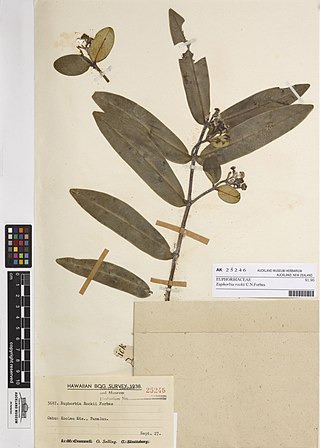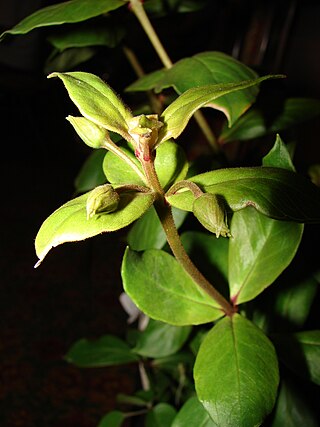
Brighamia rockii, known as the Molokai ohaha or Pua ʻala in Hawaiian, is a species of flowering plant in the bellflower family, Campanulaceae, that is endemic to the island of Molokaʻi in Hawaii. Pua ʻala inhabits mesic shrublands and forests on rocky cliffs from sea level to 470 m (1,540 ft) on the island's northern windward coast. Associated plants include ʻōhiʻa lehua, alaheʻe, lama, ʻūlei, and naupaka.

Schenkia sebaeoides, known as ʻĀwiwi in Hawaiian and lavaslope centaury in English, is a rare species of flowering plant. It is endemic to low shrublands in the state of Hawaiʻi in the United States. It is present on the islands of Kauai, Oahu, Lanai, Molokai, and Maui. At the time it was added to the endangered species list of the United States in 1991 it was known from seven populations for a total of fewer than 1000 individuals. It is threatened by habitat loss.

Euphorbia rockii is a rare species of flowering plant in the euphorb family known by the common names Koolau Range sandmat and Rock's broomspurge. It is endemic to Oʻahu, Hawaii, where it is known only from the Koʻolau Mountains. There are 200 to 300 plants remaining. Like other Hawaiian euphorbs, this plant is known locally as ʻakoko.
Cyanea dunbariae is a rare species of flowering plant in the bellflower family known by the common name ravine cyanea. It is endemic to Molokai, where there were sixteen plants remaining in the wild as of 2005. It is a federally listed endangered species of the United States. Like other Cyanea it is known as haha in Hawaiian.
Cyanea mannii is a rare species of flowering plant in the bellflower family known by the common name Mann's cyanea. It is endemic to Hawaii, where it is known only from the island of Molokai. There are 9 occurrences with fewer than 3000 plants remaining. It is a federally listed endangered species. Like other Cyanea it is known as haha in Hawaiian.

Cyanea truncata is a rare species of flowering plant in the bellflower family known by the common name Punaluu cyanea. It is endemic to the islands of Oahu and Molokai in Hawaii, but it is now critically endangered. It exists in cultivation and some individuals have been planted in appropriate habitat. It is a federally listed endangered species of the United States. Like other Cyanea it is known as haha in Hawaiian.
Melanthera kamolensis, known by the common name Maui nehe, is a rare species of flowering plant in the family Asteraceae.

Lysimachia maxima is a rare species of flowering plant in the family Primulaceae known by the common name Pelekunu Trail yellow loosestrife. It is endemic to Hawaii, where there are only two small populations remaining on the island of Molokai. It is federally listed as an endangered species of the United States.
Cyperus fauriei is a rare species of sedge known by the common name alpine flatsedge. It is endemic to Hawaii, where it grows on the islands of Molokai and Hawaii. It is a federally listed endangered species of the United States.
Melicope munroi is a rare species of flowering plant in the family Rutaceae known by the common names lanahale and Munro's pelea. It is endemic to Hawaii, where it is known only from the island of Lanai. It is a federally listed endangered species of the United States. Like other Hawaiian Melicope, this species is known as alani.
Schiedea lydgatei is a rare species of flowering plant in the family Caryophyllaceae known by the common name Kamalo Gulch schiedea and Pacific schiedea. It is endemic to Hawaii, where it is known only from the island of Molokai. It is threatened by the degradation and destruction of its habitat. It is a federally listed endangered species of the United States.
Schiedea membranacea is a rare species of flowering plant in the family Caryophyllaceae known by the common name valley schiedea. It is endemic to Hawaii, where it is known only from the island of Oahu. It has been extirpated from Maui and Molokai. Plants in a population known from Kauai are actually members of other species. Thus, the species is now endemic to Oahu. It is threatened by the degradation and destruction of its habitat. It is a federally listed endangered species of the United States.
Schiedea sarmentosa is a rare species of flowering plant in the family Caryophyllaceae known by the common name cliff schiedea. It is endemic to Hawaii, where it is known only from the island of Molokai. It is threatened by the degradation and destruction of its habitat. It is a federally listed endangered species of the United States.

Silene alexandri is a rare species of flowering plant in the family Caryophyllaceae known by the common names Kamalo Gulch catchfly and Alexander's catchfly. It is endemic to Hawaii, where it is known only from the island of Molokai. It is threatened by the degradation of its habitat and it is a federally listed endangered species of the United States.

Silene lanceolata is a rare species of flowering plant in the family Caryophyllaceae known by the common names Kauai catchfly and lanceolate catchfly. It is endemic to Hawaii, where it is known only from Oahu, Molokai, and Hawaii, having been extirpated from Kauai and Lanai. It is threatened by the degradation of its habitat and it is a federally listed endangered species of the United States.

Spermolepis hawaiiensis is a rare species of flowering plant in the carrot family known by the common name Hawai'i scaleseed. It is endemic to Hawaii, where it is known from the islands of Kauai, Maui, Oahu, Molokai, Lanai, and Hawaii. It is threatened by the degradation of its habitat and it is a federally listed endangered species.

Solanum incompletum is a rare species of flowering plant in the family Solanaceae known by the common names thorny popolo and popolo ku mai. It is endemic to Hawaii, where it occurs today on the islands of Maui, Lanai, and Hawaii. It is threatened by the destruction and degradation of its habitat. It is a federally listed endangered species of the United States.
Tetramolopium arenarium is a rare species of flowering plant in the family Asteraceae known by the common name Maui tetramolopium. It is endemic to Hawaii, where it is known only from the island of Hawaii. It is extirpated from Maui. It is threatened by the degradation of its habitat. It is a federally listed endangered species of the United States.
Tetramolopium capillare is a rare species of flowering plant in the family Asteraceae known by the common name pamakani. It is endemic to Hawaii, where it is known only from the island of Maui. There are four occurrences for a total of fewer than 200 individuals. It is threatened by the degradation of its habitat caused by introduced plant species. It is a federally listed endangered species of the United States.
Tetramolopium remyi is a rare species of flowering plant in the family Asteraceae known by the common names Awalua Ridge tetramolopium and Remy's tetramolopium. It is endemic to Hawaii, where today it is known only from the island of Lanai. It is believed to be extirpated on the island of Maui, having not been observed there since 1944. It is threatened by habitat degradation caused by deer, Mouflon, and introduced species of plants. It is a federally listed endangered species of the United States.










